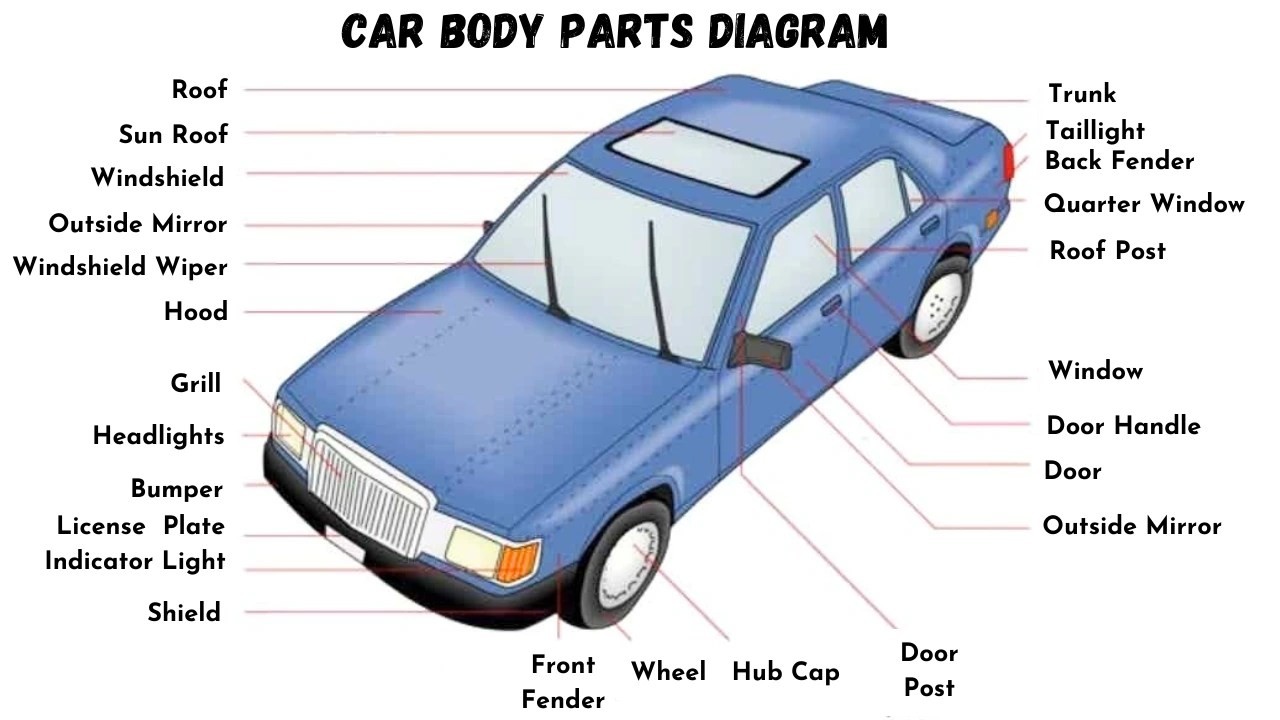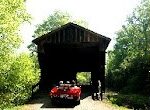Have you ever glanced at a car and wondered about the names of its various components? Just like the human body, a car is composed of numerous parts that work together to make it functional. Understanding these components, especially the body parts, is essential for car owners and enthusiasts alike. This guide will explore the primary Names Of Parts Of Car Body, detailing their functions and significance.
Essential Car Body Parts: An Overview
The car body is the exterior shell of a vehicle, encompassing a wide array of parts that contribute to its aesthetics, safety, and aerodynamics. Below is a list of the main components you’ll find on most cars:
- Body Shell
- Hood (or Bonnet)
- Front Bumper
- Rear Bumper
- Bumper Grille
- Crash Guard (or Bullbar)
- Headlight
- Fog Lamp
- Indicator Lights (Turn Signals)
- Wiper Blades
- Radiator
- Radiator Supports
- Cowl Panel
- Quarter Panel
- Fender
- Fender Liners
- Roof
- Sunroof
- Mirrors (Side and Rearview)
- Doors
- Door Handle
- Window Glass
- Quarter Window
- Trunk (or Decklid)
- Mud Flaps (or Splash Guards)
- Wheels
- Hubcap
- Dashboard
- License Plate
- Taillights
 Diagram illustrating the names of car body parts
Diagram illustrating the names of car body parts
Exploring the Car Body in Detail
Let’s delve deeper into the function and importance of each of these car body parts:
#1. Body Shell: The Foundation
The body shell is the structural framework of the car. It’s the main structure upon which all other components are mounted. Think of it as the skeleton of the car, providing rigidity and shape. It typically excludes detachable parts like doors, hoods, and exterior trim.
#2. Hood or Bonnet: Protecting the Engine
The hood, also known as the bonnet in some regions, is the hinged cover at the front of the car that protects the engine compartment. It shields the engine and related components from the elements and allows for easy access for maintenance and repairs. Hoods are usually made of steel or aluminum, and sometimes aftermarket options are available in lighter materials like carbon fiber.
#3. Front Bumper: Impact Absorption
The front bumper is a crucial safety component designed to absorb impact during a front-end collision. It’s mounted at the front of the car and helps to minimize damage to the vehicle’s structure and occupants in low-speed impacts. Bumpers often integrate with the vehicle’s design, wrapping around the front corners and sometimes incorporating elements like fog lights or parking sensors.
#4. Rear Bumper: Rear-End Protection
Similar to the front bumper, the rear bumper provides protection in rear-end collisions. It’s positioned at the back of the car and often houses the taillights and sometimes exhaust outlets. Both front and rear bumpers are vital for reducing damage in minor accidents and protecting critical components.
#5. Bumper Grille: Engine Cooling and Style
The bumper grille, often simply called the grille, is located at the front of the car, usually between the headlights. It’s designed with openings to allow air to flow into the engine compartment, cooling the radiator and engine. Grilles also play a significant role in the car’s styling and brand identity, with different manufacturers utilizing unique grille designs.
#6. Crash Guards or Bullbars: Enhanced Front Protection
Crash guards, also known as bullbars, are metal bars mounted to the front of the vehicle, primarily for added protection in off-road or rural driving conditions. They are designed to protect the front of the car from impacts with animals or debris, although their use can be controversial due to pedestrian safety concerns in urban environments.
#7. Headlights: Illuminating the Road Ahead
Headlights are essential lighting components mounted at the front of the car. They provide illumination for driving at night or in low-visibility conditions, ensuring the driver can see the road and be seen by other road users. Modern headlights come in various technologies, including halogen, LED, and xenon, each offering different levels of brightness and efficiency.
#8. Fog Lamps: Enhanced Visibility in Poor Weather
Fog lamps are supplementary lights positioned lower than the headlights, designed to improve visibility in fog, mist, heavy rain, or dust. Their lower positioning helps to direct light under the fog layer, reducing glare and illuminating the road surface more effectively than headlights in foggy conditions.
#9. Indicator Lights: Signaling Turns and Hazards
Indicator lights, also known as turn signals or signal lights, are flashing lights at the front, sides, and rear of the vehicle. They are used to signal the driver’s intention to turn or change lanes. Hazard lights use all indicator lights simultaneously to warn other drivers of a hazard or vehicle breakdown.
#10. Roof and Pillars: Structural Integrity and Protection
The roof is the top panel of the car, providing protection from the elements and contributing to the vehicle’s structural integrity. Pillars are the vertical supports that hold up the roof. They are crucial for roof support and overall vehicle strength, especially in rollover accidents. Pillars are typically designated with letters (A, B, C, etc.) from front to rear.
#11. Doors and Windows: Access and Weather Sealing
Doors provide access to the vehicle’s interior and contribute to occupant safety. They are equipped with door handles for opening and closing and door locks for security. Windows are glazed openings in the doors and body that allow visibility and light into the cabin. Window glass can be rolled down for ventilation, and the windshield (front window) is fixed and provides crucial forward visibility.
#12. Rear Panels: Completing the Rear Structure
Rear panels encompass the bodywork at the rear of the car, including the taillights, trunk lid (or decklid), and often the rear bumper. They form the back end of the vehicle and house essential lighting and access to the cargo area.
#13. Front Panels: Shaping the Front End
Front panels are the body panels at the front of the car, typically including the fenders, headlight housings, and areas around the grille and bumper. They contribute to the car’s frontal styling and aerodynamic profile.
#14. Steering Wheel and Car Wheels: Control and Mobility
While the steering wheel is an interior component, it’s intrinsically linked to the exterior wheels. The steering system, including the steering wheel, column, and linkages, allows the driver to control the direction of the front wheels. Car wheels are the circular components that allow the vehicle to move, fitted with tires for grip and cushioning.
#15. Mirrors and Wipers: Visibility Aids
Mirrors, including side mirrors (door mirrors) and the rearview mirror, are crucial for driver visibility around the vehicle. They allow the driver to see traffic and obstacles to the sides and rear. Wiper blades, powered by the windshield wiper motor, clear rain, snow, and debris from the windshield, maintaining clear forward vision.
#16. Fenders and Fender Liners: Wheel Arch Protection
Fenders are the body panels that surround the wheel arches. They protect the car body from mud, rocks, and road spray thrown up by the tires. Fender liners, also known as wheel well liners, are plastic or fabric liners inside the fenders that provide additional protection and reduce noise.
#17. Quarter Panels: Rear Side Body Sections
Quarter panels are the body panels located between the rear door and the trunk (boot). They typically wrap around the rear wheel arch and are a significant part of the car’s side profile.
#18. Sunroof: Bringing Light and Air In
A sunroof is an optional movable panel in the car roof that can be opened to allow light and fresh air into the cabin. Sunroofs are available in various types, from manually operated pop-up versions to large, electrically operated panoramic roofs.
#19. Trunk or Decklid: Rear Storage Access
The trunk, also known as the decklid or boot in some countries, is the hinged cover that provides access to the vehicle’s rear storage compartment. It’s typically located at the rear of the car and is used to store luggage and other cargo.
#20. Mud Flaps: Protecting the Undercarriage
Mud flaps, also called splash guards, are panels fitted behind the wheels, particularly the rear wheels. They are designed to prevent mud, water, and road debris from being thrown up and damaging the vehicle’s undercarriage and other vehicles.
#21. Wheels and Hubcaps: Rolling Components and Styling
Wheels are the essential components that enable the car to move. They are typically made of steel or alloy and are designed to support the vehicle’s weight and accommodate tires. Hubcaps (or wheel covers) are decorative covers that fit over the center of the wheel, enhancing the car’s appearance.
#22. Dashboard: Interior Control Center
While technically an interior part, the dashboard (or instrument panel) is mentioned in the original list. It’s the control panel located in front of the driver, housing instruments, gauges, and controls for operating the vehicle.
#23. License Plate: Vehicle Identification
The license plate (or number plate) is a metal or plastic plate attached to the exterior of the vehicle, displaying the vehicle’s registration number for legal identification.
#24. Taillights: Rear Illumination and Signaling
Taillights are lighting units at the rear of the vehicle, crucial for visibility and communication. They include brake lights (illuminated when braking), turn signals, and rear position lights (illuminated when headlights are on), ensuring the car is visible from behind, especially at night or in poor visibility.
Frequently Asked Questions (FAQs)
Q: What are common names for car body parts?
A: Common car body part names include hood/bonnet, bumper, fender, grille, roof, doors, trunk/decklid, and wheels. Understanding these terms is fundamental to discussing car maintenance and repair.
Q: What are the panels on a car called?
A: Car panels refer to the various metal or composite sections that make up the car’s exterior body. These include fenders, quarter panels, door panels, roof panel, hood, and trunk lid.
Q: What is considered the main part of a car?
A: While many parts are essential, the chassis is often considered the main structural part of a car. It provides the frame and support for the body and all other components.
Q: How can I identify a specific car part?
A: The most reliable way to identify a car part is by using the Vehicle Identification Number (VIN). This unique code can be used to find parts specifically designed for your vehicle model. Sometimes, parts also have part codes directly printed on them.
Q: What is the front body part covering the engine called in British English?
A: In British English, the front body part covering the engine is called the bonnet. In American English, it’s called the hood.
Understanding the names of parts of car body is more than just automotive jargon; it’s practical knowledge that empowers car owners and enthusiasts to better understand, maintain, and appreciate their vehicles.
